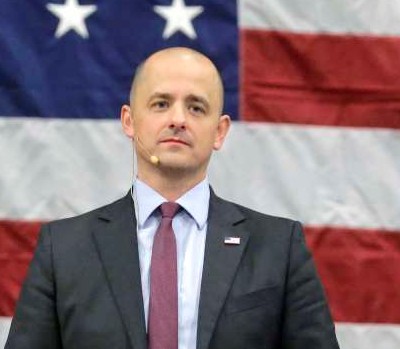Liberal Media Promoted Evan McMullin’s Conservative Insurgency in Utah, but Polls Painted Different Picture
on
 Evan McMullin, a late-entry presidential candidate, ran as the conservative alternative to Donald Trump. As member of the church of Jesus Christ of Latter Day Saints, and a former Central Intelligence Agency (CIA) analyst, he was uniquely positioned to offer the state of Utah an alternative third-party candidate. Utah has a significant LDS (also known as “Mormons”) population which had not put their primary vote behind Trump, but had gone mostly for Ted Cruz in the party primaries. Mitt Romney, also a member of the church of Jesus Christ of Latter Day Saints, spoke at the University of Utah in the primary season and issued a strong “Never Trump” statement to dissuade Utahans and others from voting for Trump.
Evan McMullin, a late-entry presidential candidate, ran as the conservative alternative to Donald Trump. As member of the church of Jesus Christ of Latter Day Saints, and a former Central Intelligence Agency (CIA) analyst, he was uniquely positioned to offer the state of Utah an alternative third-party candidate. Utah has a significant LDS (also known as “Mormons”) population which had not put their primary vote behind Trump, but had gone mostly for Ted Cruz in the party primaries. Mitt Romney, also a member of the church of Jesus Christ of Latter Day Saints, spoke at the University of Utah in the primary season and issued a strong “Never Trump” statement to dissuade Utahans and others from voting for Trump.
McMullin’s plan was to provide a conservative vision for America, one built on strong national security and a robust foreign policy. He also was pushing a message of unity, echoing the legacy of Ronald Reagan. He named Mindy Finn, a prominent female Jewish conservative activist, as his running mate, and had the financial backing of neoconservative establishment Republican Bill Kristol, who is in charge of The Weekly Standard magazine and is often on ABC News as a contributor.
In October, an Emerson College poll announced that McMullin took the lead in the state of Utah with 31% of the vote. Trump was second at 27% and Clinton 24%. McMullin voters and the media pounced on the news and believed Utah could vote for a third party candidate for the first time in its history. A red state had not gone blue, but third party. This added to speculation that if McMullin won Utah, , and the vote between Clinton and Trump was so close that neither would win 270 electoral votes, the presidential vote could go to the House of Representatives and McMullin could conceivably be voted as president of the United States.
However, the media quickly moved on from the story and the McMullin campaign gained momentum. The fact remained that in a subsequent Emerson College poll, McMullin was not within earshot of Trump when Trump took the lead on November 3rd with 40%, compared to McMullin’s 28%.
Other polls, ranging from the local Salt Lake Tribune to Heat Street/Rasmussen to Monmouth, did not put McMullin ahead of Trump in the few weeks before Election Day. Trump’s polling numbers did not dip below 32% in seven different polls conducted after the Emerson College poll in October. Yet, there was little-to-no liberal media coverage of this polling trend in favor of Trump.
But, on election night, McMullin quickly surged to second place in the state of Utah before finishing third with 21% of the vote, behind Democratic Party nominee Hillary Clinton who had 28%. The state stayed red, and although McMullin briefly challenged Trump, it wasn’t close at all in the end.
McMullin’s concession speech was a plea for a new conservative movement and to not let the momentum or the movement die. But, some questions remain: What are the changing demographics of Utah? Is another conservative insurgency on the horizon in four years for the next presidential election? Time will tell.
This article is republished with permission from our friends at Accuracy in Media.
Utah Standard News depends on the support of readers like you.
Good Journalism requires time, expertise, passion and money. We know you appreciate the coverage here. Please help us to continue as an alternative news website by becoming a subscriber or making a donation. To learn more about our subscription options or make a donation, click here.
To Advertise on UtahStandardNews.com, please contact us at: ed@utahstandardnews.com.


Comments - No Responses to “Liberal Media Promoted Evan McMullin’s Conservative Insurgency in Utah, but Polls Painted Different Picture”
Sure is empty down here...